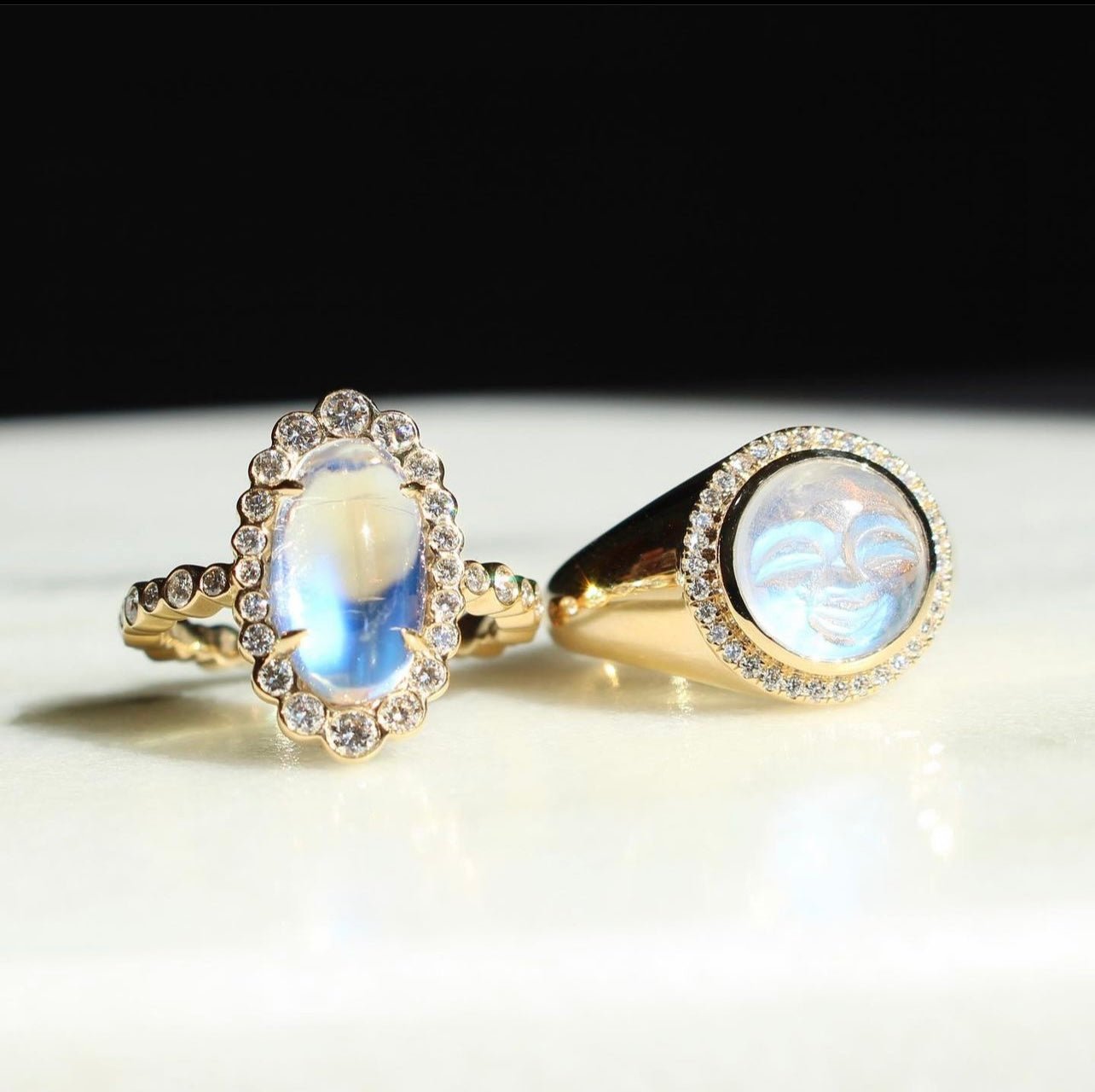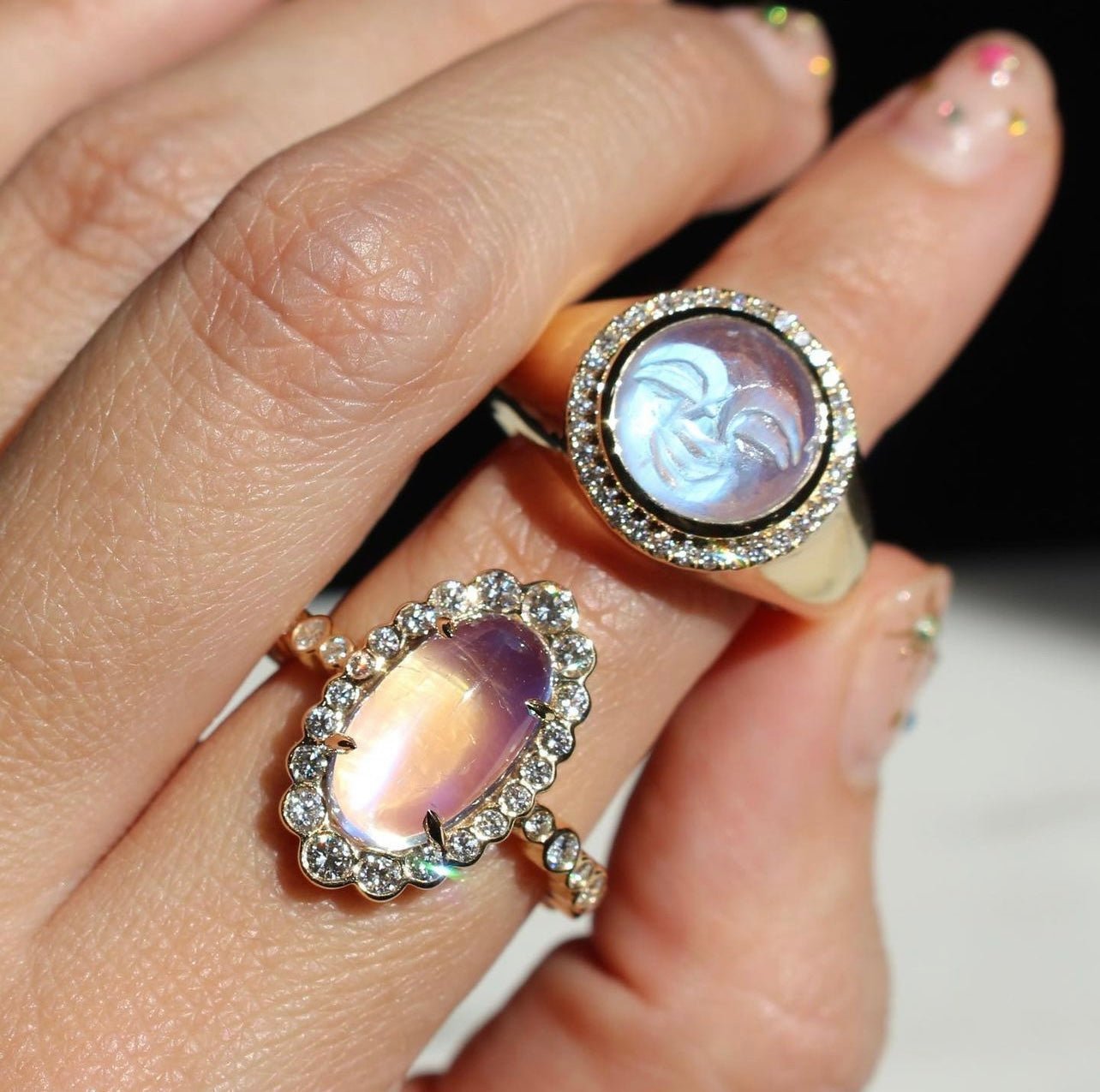Title: Gemstone vs. Diamond: What You Need To Know
URL: https://www.markhenryjewelry.com/blogs/news/gemstone-vs-diamond
Meta Description: Are you stuck between the timeless diamond and the modern gemstone? Read on to compare and contrast your various options.
Gemstone vs. Diamond: What You Need To Know
Are you someone who prefers classic jewelry, or do you want to spice up your wardrobe a bit? Both diamonds and gemstones come in excellent varieties of value and color, as well as price. However, the real difference between the two is their rarity and symbolic meanings.
Sure, diamonds are timeless in the jewelry world — and in the world in general. They have been long lauded throughout history as a show of wealth and status. Oftentimes, they were even traded as a form of currency. We don’t predict a total ruin of the allure that diamonds hold over the jewelry industry, but we’re here to offer an alternative route.
Diamonds, the birthstone for April babies, have spent millions of years at the forefront of the jewelry world. At Mark Henry, we respect this well-deserved appreciation. But as exotic gemstone aficionados, we believe that they often pale in comparison to the vibrance and unique qualities of their counterparts.
Before you tell your partner you’d like to replace your diamond ring with another fine gem, let’s compare our options. When it comes to jewelry, there is always room for every crystal! It's up to you to deem which piece you prefer.
Are Diamonds the Rarest Stone?
It might come as a surprise, but diamonds are actually not as rare as the world believes. In fact, most exotic gemstones immediately surpass the rarity of diamonds. Alexandrite, a favorite gemstone of ours, is rarer than rubies, emeralds, and (you guessed it) diamonds.
When collectors find this information out, they often feel a bit deceived. The jewelry industry has spent money and time building up the image of diamonds as the most prized stone to own. Diamonds are definitely rare, just to a lesser degree than fine gems.
Consider the engagement rings of your friends and family. We’re willing to bet that most, if not all, include a diamond. How many of those rings have a tourmaline or a precious turquoise?
Likely few, if any. Rarity is also measured by how common a stone is. The fewer the mines available for a gemstone, the rarer it is — hundreds of millions of carats of diamonds are mined every year.
What Makes Diamonds So Appealing?
What makes diamonds so appealing to the masses is their iconic look. They’ve been called “a girl’s best friend” in popular media and beloved from generation to generation. They are also generally thought of as the best symbol for undying love, especially when it comes to jewelry gifted in romantic relationships.
Timeless
You’re more likely to inherit a diamond jewelry piece from an elder relative due to their wide presence. In 1477, Archduke Maximilian I of Austria presented Mary of Burgundy with a diamond ring, starting the tradition.
If you love the classics, diamonds are a great option and will remain in style as other trends come and go. They are a great heirloom piece that holds up to everyday wear.
Properties
Diamonds are remarkably hard and durable to an extent. This is one of the reasons why they work so well in ring placements. They rank a 10 on the Mohs scale of hardness, which is the highest durability that you can achieve. Even the hardest of gemstones don’t stack up, but it is worth noting that diamonds can still always be scratched when tested.
Diamonds are also known to come in many colors. This can be appealing to those who want a bit of flair but not a new gemstone altogether. They range in quality, but fancy colored diamonds are typically the best finds with the highest saturations and best tones. We’ll explore the diamond grading scales later on, but for now, you should know that diamond color is measured from D-Z and 1-10 by different laboratories.
Some people favor colorless diamonds over those with noticeable tints. When diamonds have nitrogen impurity, they can come in yellow shades. Canary yellow is fairly valuable, but other yellow and brown diamonds rank low on the quality scale. It is important to do your research before you purchase a colored diamond.
The Allure of Gemstones: What To Know
Fine and exotic gemstones have a more straightforward storyline in terms of value and rarity. While they have a wider variety than diamonds because they all come from different crystal families, the research that has been done on them individually makes them easier to grade by appearance alone. This can improve your chances of making a quality investment when shopping.
Variety
If you didn’t find what you were looking for in colored diamond offerings, gemstones will satisfy your search. They come in highly saturated and vibrant hues, some of which are even pleochroic, like one of our favorite fine gemstones, alexandrite.
Gemstones vs. Diamonds: Mohs Hardness Scale
Gemstones are more likely to have inclusions than diamonds because they are rarely colorless. This might be a turnoff for some potential buyers. In gems like Paraiba tourmaline, “centipede” like inclusions don’t impact value or quality at all. Turquoise can sometimes sell for higher values if it presents with unique inclusion-made patterns.
Gemstones vary widely in terms of hardness. For stones like alexandrite, they are very durable, sitting at an 8-8.5 on the Mohs scale. For others, like moonstones, they can actually be very soft. In situations like these, it may be better to consult a jeweler for what pieces the stones are best added into. We’d suggest avoiding rings and bracelets for softer stones.
Grading Scales
Since diamonds and gemstones have such different characteristics, they naturally have different metrics for grading quality. Diamonds have some of the most well-known criteria, called the 4Cs. Gemstones base their value scales on these characteristics but add in additional measures that have more to do with maximizing saturation and monitoring inclusions.
Diamond Grading
The 4Cs scale was designed by the Gemological Institute of America and embraces the ranking of clarity, color, cut, and carat weight to determine overall quality.
Clarity is the most crucial metric for diamonds because a murky or clouded diamond is not very valuable. The scale ranges from Flawless (the best) to Included (the worst). As we’ve mentioned, inclusions don’t always determine gemstone value as much as diamond value.
The American Gemological Society has its own scale for rating diamond quality, and this is based on numbers from 0-10 in an effort to improve its accessibility. If you’re requesting data on a diamond, ask for the AGS grade. This might be easier to read and understand.
Gemstone Grading
When it comes to gemstones, clarity, cut, color, and carat weight do still matter. However, these stones are also graded based on saturation, fractures, and symmetry. Gemstones can have vastly different properties from one another, so it is harder to compare them through standardized metrics.
A highly saturated emerald with a Type III clarity ranking (always included) can be more expensive and higher quality than an eye-clean tourmaline lacking in saturation.
The cut of diamonds is significant, but it is even more essential in gemstones. Windowing, an issue where a gemstone takes light internally instead of projecting it outward, can lower price and value. Cabochons are a type of cut gemstone that reflects light in a cohesive way.
What Are Lab-Made Diamonds and Gemstones Worth?
Lab-made diamonds and gemstones can be a decent alternative to the real deal, especially if you’re on a very tight budget. They don’t compare in quality, though. They also definitely have no rarity because they are not naturally mined.
Diamonds have some of the most accurate and easily accessible imitations and lab creations. Other gemstones are typically harder to find imitations of that are worth your money. However, some (like alexandrite) have close lab-made counterparts.
What Are Some Diamond Alternatives?
White Gemstones
If you’re interested in diamond alternatives for price consciousness, look into pieces like synthetic white sapphires. They are nearly identical in appearance to diamonds but are a fraction of the price and can easily be replaced. Lab-created diamonds are on the pricier end and might not be worth skipping over natural diamonds for.
Other diamond alternatives are the gemstones white topaz, white zircon, quartz, and white sapphire. All of these are naturally mined and authentic, which adds to their overall investment value. They will radiate shine like no other, far greater than any synthetic or simulant stone.
Cubic Zirconia
Russian scientists invented Cubic Zirconia in the 1970s, and it has been famous ever since. The zirconium dioxide gemstone may be lab-made, but its starting price ranges from $20 to $40.
While diamonds require constant upkeep, cubic zirconia is so affordable that its replacement won’t make you sweat. These gems are perfect for wearing while washing dishes or swimming.
Priceless vs. Pristine
The decision between diamonds and gemstones comes down to what you value and not what gemologists care about. Both choices have a little something for everyone to enjoy, so follow your heart to the piece you most desire.
Sources:
Ten Gemstones Rarer than Diamond | International Gem Society
A Consumer's Guide to Gem Grading | International Gem Society
What's the Best Diamond Alternative? | International Gem Society

